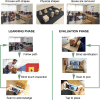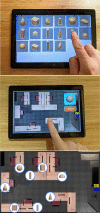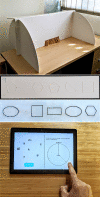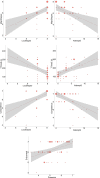SLAM-based augmented reality for the assessment of short-term spatial memory. A comparative study of visual versus tactile stimuli
- PMID: 33539369
- PMCID: PMC7861452
- DOI: 10.1371/journal.pone.0245976
SLAM-based augmented reality for the assessment of short-term spatial memory. A comparative study of visual versus tactile stimuli
Abstract
The assessment of human spatial short-term memory has mainly been performed using visual stimuli and less frequently using auditory stimuli. This paper presents a framework for the development of SLAM-based Augmented Reality applications for the assessment of spatial memory. An AR mobile application was developed for this type of assessment involving visual and tactile stimuli by using our framework. The task to be carried out with the AR application is divided into two phases: 1) a learning phase, in which participants physically walk around a room and have to remember the location of simple geometrical shapes; and 2) an evaluation phase, in which the participants are asked to recall the location of the shapes. A study for comparing the performance outcomes using visual and tactile stimuli was carried out. Fifty-three participants performed the task using the two conditions (Tactile vs Visual), but with more than two months of difference (within-subject design). The number of shapes placed correctly was similar for both conditions. However, the group that used the tactile stimulus spent significantly more time completing the task and required significantly more attempts. The performance outcomes were independent of gender. Some significant correlations among variables related to the performance outcomes and other tests were found. The following significant correlations among variables related to the performance outcomes using visual stimuli and the participants' subjective variables were also found: 1) the greater the number of correctly placed shapes, the greater the perceived competence; 2) the more attempts required, the less the perceived competence. We also found that perceived enjoyment was higher when a higher sense of presence was induced. Our results suggest that tactile stimuli are valid stimuli to exploit for the assessment of the ability to memorize spatial-tactile associations, but that the ability to memorize spatial-visual associations is dominant. Our results also show that gender does not affect these types of memory tasks.
Conflict of interest statement
The authors have declared that no competing interests exist.
Figures









Similar articles
-
Extended Reality to Assess Short-Term Spatial Memory-A Comparative Study of Mixed Reality, Augmented Reality, and Virtual Reality.Sensors (Basel). 2024 Dec 12;24(24):7938. doi: 10.3390/s24247938. Sensors (Basel). 2024. PMID: 39771675 Free PMC article.
-
Sequential neural processes of tactile-visual crossmodal working memory.Neuroscience. 2006 Apr 28;139(1):299-309. doi: 10.1016/j.neuroscience.2005.05.058. Epub 2005 Dec 1. Neuroscience. 2006. PMID: 16324794
-
Independent Attention Mechanisms Control the Activation of Tactile and Visual Working Memory Representations.J Cogn Neurosci. 2018 May;30(5):644-655. doi: 10.1162/jocn_a_01239. Epub 2018 Jan 18. J Cogn Neurosci. 2018. PMID: 29346019
-
Attending to and remembering tactile stimuli: a review of brain imaging data and single-neuron responses.J Clin Neurophysiol. 2000 Nov;17(6):575-91. doi: 10.1097/00004691-200011000-00004. J Clin Neurophysiol. 2000. PMID: 11151976 Review.
-
The challenge of neuropsychological assessment of visual/visuo-spatial memory: A critical, historical review, and lessons for the present and future.Front Psychol. 2022 Aug 23;13:962025. doi: 10.3389/fpsyg.2022.962025. eCollection 2022. Front Psychol. 2022. PMID: 36081731 Free PMC article. Review.
Cited by
-
Comparing episodic memory outcomes from walking augmented reality and stationary virtual reality encoding experiences.Sci Rep. 2024 Mar 30;14(1):7580. doi: 10.1038/s41598-024-57668-w. Sci Rep. 2024. PMID: 38555291 Free PMC article.
-
Involvement in bullying and sleep disorders in Chinese early adolescents.Front Psychiatry. 2023 Apr 27;14:1115561. doi: 10.3389/fpsyt.2023.1115561. eCollection 2023. Front Psychiatry. 2023. PMID: 37181869 Free PMC article.
-
Extended Reality to Assess Short-Term Spatial Memory-A Comparative Study of Mixed Reality, Augmented Reality, and Virtual Reality.Sensors (Basel). 2024 Dec 12;24(24):7938. doi: 10.3390/s24247938. Sensors (Basel). 2024. PMID: 39771675 Free PMC article.
References
Publication types
MeSH terms
LinkOut - more resources
Full Text Sources
Other Literature Sources
Research Materials

